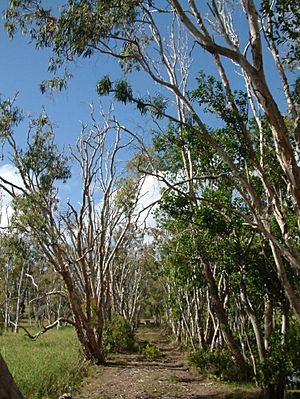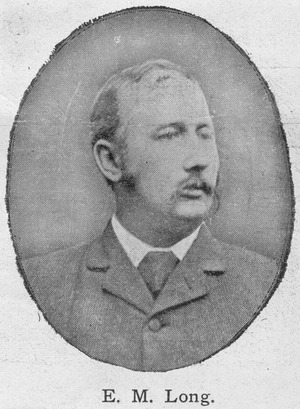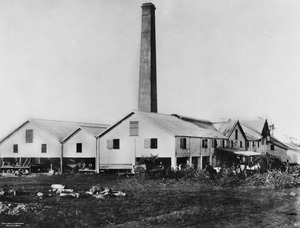Habana Tramline Causeway and Wharf Site facts for kids
Quick facts for kids Habana Tramline Causeway and Wharf Site |
|
|---|---|

Habana Causeway, 2006
|
|
| Location | Between Habana Wharf Road and Constant Creek, Habana, Mackay Region, Queensland, Australia |
| Official name: Habana Tramline Causeway and Wharf Site, Habana Wharf Road | |
| Type | state heritage (built) |
| Designated | 14 May 2010 |
| Reference no. | 602749 |
| Significant period | 1882-1901 |
| Lua error in Module:Location_map at line 420: attempt to index field 'wikibase' (a nil value). | |
The Habana Tramline Causeway and Wharf Site is a special historical place in Habana, Australia. It includes a stone and gravel causeway and the remains of an old wharf. This site is important because it shows how sugar was produced in Queensland a long time ago. It was added to the Queensland Heritage Register in 2010.
Contents
Building the Causeway and Wharf
The causeway and wharf were built around 1882-1883. They were made to help transport sugar from the Habana sugar plantation. This plantation was owned by Edward Maitland Long and William Robertson.
The causeway was built by Melanesian workers, often called South Sea Islanders. These workers were brought to Queensland to help with the growing sugar industry. The wharf was built on Constant Creek, which flows into the ocean.
Sugar Industry in Mackay
The area around Mackay is famous for its sugar industry. The city itself is named after John Mackay, who explored the area in 1860. The first sugar plantation in Mackay started in 1865.
South Sea Islanders played a huge role in Queensland's early sugar industry. Between 1863 and 1904, about 50,000 Islanders came to Queensland. They usually worked under a three-year contract. They provided much of the manual labor needed for the sugar fields.
Most Islanders came from islands in what are now Vanuatu and the Solomon Islands. How they were recruited is still debated. Some were brought against their will.
These workers were vital for the sugar industry. They did almost all the field work in the early days. Many returned home after their contracts ended. The Pioneer River valley, near Mackay, has always had a large South Sea Islander population.
The Sugar Boom and Changes
The sugar industry grew very fast in the early 1880s. Mackay became a busy port and business center. This period was the peak of the "plantation system." In this system, large farms grew sugar cane using South Sea Islander labor. Each plantation had its own sugar mill.
The Habana mill, owned by Long and Robertson, opened in 1883. By 1884, a lot of land in the Mackay area was used for sugar plantations. However, this system faced challenges.
The price of sugar dropped in 1884. Also, more small farmers started growing sugar cane. These small farmers preferred to crush their cane at larger, "central" mills. The Queensland Premier, Sir Samuel Griffith, wanted to break up large plantations into smaller farms. This was seen as a better way for Queensland to develop.
There were also concerns about the use of South Sea Islander labor. Some groups worried about their treatment. Labor unions, which were mostly white, felt threatened by cheaper non-European labor.
Because of these reasons, laws were passed to limit Islander labor. By 1901, after Australia became a country, new laws stopped the recruitment of South Sea Islanders. Most were sent back to their home islands by 1908.
Large central mills, often supported by the government, eventually replaced the smaller plantation mills. These central mills were more efficient. The Habana mill closed in 1901.
The Habana Plantation and its Transport
Edward Long owned several land blocks in the Habana area. He and William Robertson developed the Habana plantation. The causeway and wharf were built to help transport sugar from their plantation.
In 1882, Long asked to lease or buy land for a wharf on Constant Creek. He had already spent a lot of money building the causeway for a tramway. The causeway was built between January and August 1882. The wharf was built after September 1882.
South Sea Islander workers built the Habana wharf and the causeway. Edward Long relied heavily on their labor. He believed they were reliable workers.
It is said that many South Sea Islanders were hurt or killed while building the causeway. They were not used to working with horses. Their graves are reportedly on a hill near the wharf site.
The Habana mill's machinery was brought through the Habana wharf in 1883. The creek was deep enough for steamers. The tramway helped avoid the high cost of transporting sugar to Mackay by road.
The Habana mill operated from 1883 to 1901. Long tried to adapt to the changing sugar industry. He started leasing land to small farmers to supply his mill. He also encouraged British and Japanese workers to come to Habana.
By 1893, many white and Islander workers were at the Habana mill and on the farms. In 1896, Long and Robertson had 1300 acres of cane and 17 miles of tramway.
Edward Long was an important public figure in Mackay. He was the first chairman of the Mackay Harbour Board. He died in 1905.
After the mill closed, the Habana Provisional School also closed in 1906. In 1907, the lease for the wharf site was not renewed. A tramline from Pleystowe Central Mill reached Habana in 1908. The area continued to grow with small cane farms and dairying.
The Habana wharf was a popular fishing spot for a while. It was still there in the 1930s. Today, you can't see the wharf structure anymore.
What the Site Looks Like Today
The causeway is about 1 kilometer long. It starts in a field at the end of Habana Wharf Road. You can see an avenue of paperbark trees marking its path.
The first part of the causeway is low and can flood. It then crosses higher ground. The rest of the causeway is made of stone and gravel. It stands about 30 centimeters above the surrounding salt marsh. You won't see any parts of the old tramway on the causeway itself.
The causeway ends at a sandy beach. From there, you can still see loose stones and pieces of corroded tramway line across the sand. These lead towards a line of mangroves. There are also some large posts near the mangroves.
To the south of the old tramway path, there's a raised area of stones. This might have been a place for trams to turn around or a work area. You can't see any parts of the wharf on the creek bank today.
Why This Place is Important
The Habana Tramline Causeway and Wharf Site is important for several reasons:
- History of Queensland's Sugar Industry: It shows how the sugar industry developed in Queensland. It represents the early "plantation system" that relied on South Sea Islander workers.
- Rare Evidence of Construction: The causeway is a rare example of a large construction project built by South Sea Islander labor. Later laws stopped them from doing such construction work. The causeway's design and tramline remnants also show how important transport was for sugar plantations in the 1800s.
- Archaeological Potential: The wharf site has old metal tramway pieces and stone platforms. These could help us learn more about how a 19th-century sugar plantation wharf operated.
- Connection to South Sea Islanders: This site is important because it shows the big contribution South Sea Islanders made to Queensland's sugar industry. It also reminds us of the difficult lives these workers had. Stories say some workers died during its construction, making it a symbolic place for them.



